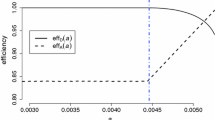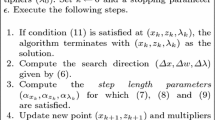Abstract
Finding a c-optimal design of a regression model is a basic optimization problem in statistics. We study the computational complexity of the problem in the case of a finite experimental domain. We formulate a decision version of the problem and prove its \(\boldsymbol{\mathit{NP}}\)-completeness. We provide examples of computationally complex instances of the design problem, motivated by cryptography. The problem, being \(\boldsymbol{\mathit{NP}}\)-complete, is then relaxed; we prove that a decision version of the relaxation, called approximate c-optimality, is P-complete. We derive an equivalence theorem for linear programming: we show that the relaxed c-optimality is equivalent (in the sense of many-one LOGSPACE-reducibility) to general linear programming.
Similar content being viewed by others
References
Agrawal, M., Kayal, N., Saxena, N.: PRIMES is in P. Ann. Math. 160, 781–793 (2004)
Atkinson, A., Donev, A., Tobias, R.: Optimum Experimental Designs with SAS. Oxford University Press, Oxford (2007)
Dobkin, D., Lipton, R., Reiss, S.: Linear programming is log-space hard for P. Inf. Process. Lett. 8(2), 96–97 (1979)
Garey, M., Johnson, D.: Computers and Intractability. A Guide to the Theory of NP-Completeness. Freeman, New York (1979)
Greenlaw, R., Hoover, H., Ruzzo, W.: Limits to Parallel Computation. P-completeness Theory. Oxford University Press, Oxford (1995)
Harman, R., Jurík, T.: Computing c-optimal experimental designs using the simplex method of linear programming. Comput. Stat. Data Anal. 53, 247–254 (2008)
Khachyian, L.: A polynomial algorithm for linear programming. Dokl. Soviet Acad. Sci. 244(5), 1093–1096 (1979)
Papadimitriou, C.: Computational Complexity. Addison-Wesley, Longman (1995)
Pázman, A.: Foundations of Optimum Experimental Design. Reidel, Dordrecht (1986)
Pukelsheim, F., Rieder, S.: Efficient rounding in approximate designs. Biometrika 79, 763–770 (1992)
Schrijver, A.: Theory of Linear and Integer Programming. Wiley, New York (1986)
Author information
Authors and Affiliations
Corresponding author
Rights and permissions
About this article
Cite this article
Černý, M., Hladík, M. Two complexity results on c-optimality in experimental design. Comput Optim Appl 51, 1397–1408 (2012). https://doi.org/10.1007/s10589-010-9377-8
Received:
Published:
Issue Date:
DOI: https://doi.org/10.1007/s10589-010-9377-8




